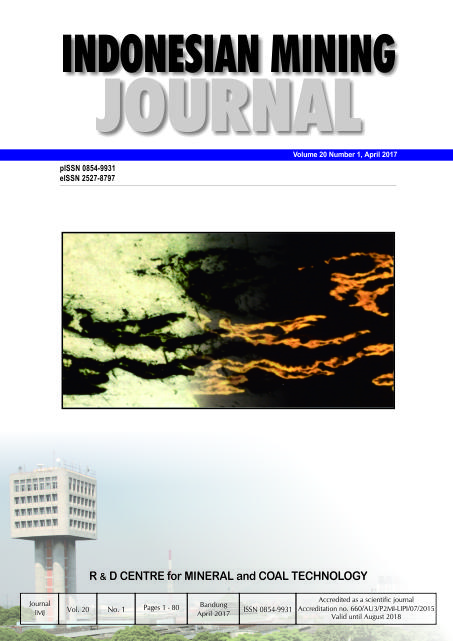DISTRIBUTION CHARACTERISTICS OF FERRO-TITANIUM OXIDE MINERAL ON LOW-GRADE IRON SAND
DOI:
https://doi.org/10.30556/imj.Vol20.No1.2017.181Keywords:
iron sand, particle size, magnetic separation, titanium oxideAbstract
Iron sand is known as one of the sources of TiO2 in the form of ilmenite or titanomagnetite mineral. Iron-titanium oxide mineral contained in Indonesia iron sand are classified as titanomagnetite. Indonesia possesses a lot of iron sand deposits such as at southern coast of Cilacap, Kebumen and other areas. The iron sand consists of magnetic and non-magnetic minerals as either loses or bound materials. Fractionation of Cilacap iron sand which employed three types of sieve (40, 60 and 80 meshes) showed that the iron sand is dominant in -40+60 fraction (68.38 g) while the most amount of iron and titania contents occurred at fraction of -80 mesh, namely 11.62 and 1.46%. Magnetic separation showed that the finer the particles and the higher the magnetic intensity, the higher the derived iron and titania. The process has also successfully increased the TiO2 content more than 5 times, from 0.325 to 1.67%.References
Adams, R. (2016) Drivers of demand for TiO2 feedstocks. Melbourne.
Ansori, C. (2013) “Mengoptimalkan perolehan mineral magnetik pada proses separasi magnetik pasir besi pantai selatan Kabupaten Kebumen, Jawa Tengah,” Jurnal Teknologi Mineral dan Batubara, 9(3), pp. 145–156.
Arndt, N., Kesler, S. and Ganino, C. (2015) “Classification, distribution and uses of ores and ore deposits,” in Metals and Society. 2nd Editio. Cham: Springer International Publishing, pp. 15–40. doi: 10.1007/978-3-319-17232-3_2.
Babu, N., Vasumathi, N. and Rao, R. B. (2009) “Recovery of ilmenite and other heavy minerals from teri sands (red sands) of Tamil Nadu, India,” Journal of Minerals and Materials Characterization and Engineering, 8(2), pp. 149–159. doi: 10.4236/jmmce.2009.82013.
Barlow, E. (2015) A review of global supply and demand for titanium dioxide, PCIMagazine (Paint and Coating Industry). Available at: http://www.pcimag.com/articles/100036-a-review-of-global-supply-and-demand-for-titanium-dioxide (Accessed: July 17, 2016).
Bedinger, G. M. (2015) “Titanium and titanium dioxide.” United State of America.
Beer, C., Stenderup, K., Wang, J., Sutherland, D. S. and Nyengaard, J. R. (eds.) (2015) Dermal abdorption of nanomaterials titanium dioxide and zinc oxide based sunscreen. Environmen. Copenhagen K: The Danish Environmental Protection Agency.
Gázquez, M. J., Bolívar, J. P., Garcia-Tenorio, R. and Vaca, F. (2014) “A review of the production cycle of titanium dioxide pigment,” Materials Sciences and Applications, 5(7), pp. 441–458. doi: 10.4236/msa.2014.57048.
Justicia, I., Ordejón, P., Canto, G., Mozos, J. L., Fraxedas, J., Battiston, G. A., Gerbasi, R. and Figueras, A. (2002) “Designed self-doped titanium oxide thin films for efficient visible-light photocatalysis,” Advanced Materials, 14(19), pp. 1399–1402. doi: 10.1002/1521-4095(20021002)14:19<1399::AID-ADMA1399>3.0.CO;2-C.
Middlemas, S., Fang, Z. Z. and Fan, P. (2013) “A new method for production of titanium dioxide pigment,” Hydrometallurgy, 131–132, pp. 107–113. doi: 10.1016/j.hydromet.2012.11.002.
Premaratne, W. A. P. J. and Rowson, N. A. (2004) “Recovery of titanium from beach sand by physical separation,” The European Journal of Mineral Processing and Environmental Protection, 4(3), pp. 183–193.
Shaheed, M. A. and Hussein, F. H. (2015) “Preparation and Applications of Titanium Dioxide and Zinc Oxide Nanoparticles,” Journal of Environmental Analytical Chemistry, 2(1), pp. 1–3. doi: 10.4172/JREAC.1000e109.
Sprong, C., Bakker, M., Niekerk, M. and Vennemann, F. (2015) Exposure assessment of the food additive titanium dioxide (E 171) based on use levels provided by the industry. Dutch: RIVM.
Sufiandi, D. (2011) “Konsentrasi pasir besi titan dari pengotornya dengan cara magnetik,” Metalurgi (Majalah Ilmu dan Teknologi), 6(1), pp. 15–20. doi: 10.14203/mtl.v26i1.4.
Sunaryo and Sugihartono, I. (2010) “Pemisahan senyawa titanomagnetit Fe3-xTixO4(o
Tampubolon, A. (2013) “The Indonesian titanium deposit types and their resources; The aspects for titanium commodity development,” Buletin Sumber Daya Geologi, 8(3), pp. 100–110.
Whitfield, R., Brown, F., Wood, L. and Branco, J. (2016) The economic benefits of chlorine chemistry in titanium and titanium dioxide in the United States and Canada.
Zhang, W., Zhu, Z. and Cheng, C. Y. (2011) “A literature review of titanium metallurgical processes,” Hydrometallurgy, 108(3–4), pp. 177–188. doi: 10.1016/j.hydromet.2011.04.005.
Downloads
Published
Issue
Section
License
Indonesian Mining Journal provides immediate open access to its content on the principle that making research freely available to the public to supports a greater global exchange of knowledge.

This work is licensed under a Creative Commons Attribution-NonCommercial 4.0 International License.













